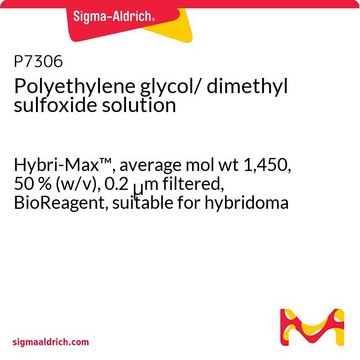P2906
Poly(ethylene glycol)
Hybri-Max™, mol wt 3,000-3,700, waxy solid, BioReagent, suitable for hybridoma
Synonym(s):
Polyethylene glycol, PEG
Sign Into View Organizational & Contract Pricing
All Photos(1)
About This Item
Linear Formula:
H(OCH2CH2)nOH
CAS Number:
MDL number:
UNSPSC Code:
12161902
PubChem Substance ID:
NACRES:
NA.75
Recommended Products
biological source
synthetic (organic)
Quality Level
grade
Hybri-Max™
sterility
autoclaved
product line
BioReagent
form
waxy solid
mol wt
3,000-3,700
technique(s)
cell culture | hybridoma: suitable
impurities
endotoxin, tested
SMILES string
C(CO)O
InChI
1S/C2H6O2/c3-1-2-4/h3-4H,1-2H2
InChI key
LYCAIKOWRPUZTN-UHFFFAOYSA-N
Looking for similar products? Visit Product Comparison Guide
General description
Poly(ethylene glycol) (PEG) is a non-ionic hydrophilic polymer and is available in different molecular weights. It either exists in the form of a linear or branched structure. It aids in the purification and crystal growth of proteins and nucleic acids. PEG along with dextran is used to achieve an aqueous polymer two-phase system, which is essential for the purification of biological materials. It permits cell fusion through its interaction with the cell membrane.
Application
Poly(ethylene glycol) has been used in the production of monoclonal antibodies.
Recommended for cell fusion.
Recommended for cell fusion.
Legal Information
Hybri-Max is a trademark of Sigma-Aldrich Co. LLC
Storage Class Code
11 - Combustible Solids
WGK
WGK 1
Flash Point(F)
281.5 °F - closed cup
Flash Point(C)
138.6 °C - closed cup
Personal Protective Equipment
dust mask type N95 (US), Eyeshields, Gloves
Choose from one of the most recent versions:
Already Own This Product?
Find documentation for the products that you have recently purchased in the Document Library.
Customers Also Viewed
Extensive nuclear localization of alpha-synuclein in normal rat brain neurons revealed by a novel monoclonal antibody
Yu S, et al.
Neuroscience journal, 145(2), 539-555 (2007)
Harris JM
Poly(Ethylene Glycol) Chemistry: Biotechnical and Biomedical Applications (2013)
Agathe Dubuisson et al.
Cell death & disease, 10(2), 101-101 (2019-02-06)
Development of therapeutic antibodies in oncology has attracted much interest in the past decades. More than 30 of them have been approved and are being used to treat patients suffering from cancer. Despite encouraging results, and albeit most clinical trials
Idalis Villanueva et al.
Acta biomaterialia, 5(8), 2832-2846 (2009-06-11)
The pericellular matrix (PCM) surrounding chondrocytes is thought to play an important role in transmitting biochemical and biomechanical signals to the cells, which regulates many cellular functions including tissue homeostasis. To better understand chondrocytes interactions with their PCM, three-dimensional poly(ethylene
Mark A Rice et al.
Acta biomaterialia, 5(1), 152-161 (2008-09-17)
Ultrasound has potential as a non-destructive analytical technique to provide real-time online assessments of matrix evolution in cell-hydrogel constructs used in tissue engineering. In these studies, chondrocytes were encapsulated in poly(ethylene glycol) hydrogels, and gel degradation was manipulated to provide
Our team of scientists has experience in all areas of research including Life Science, Material Science, Chemical Synthesis, Chromatography, Analytical and many others.
Contact Technical Service


